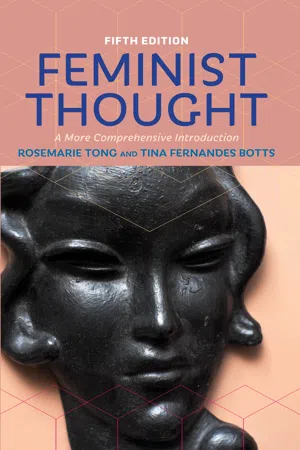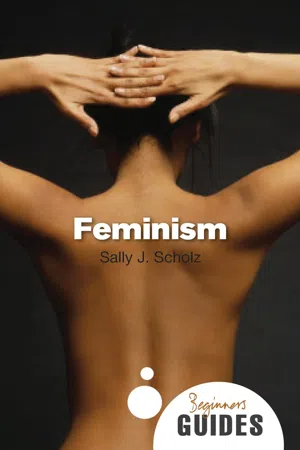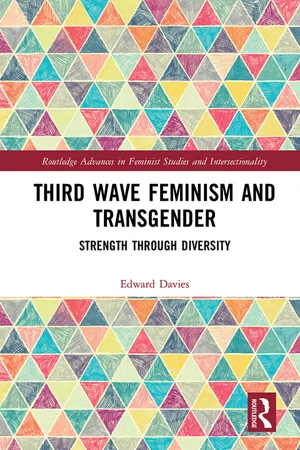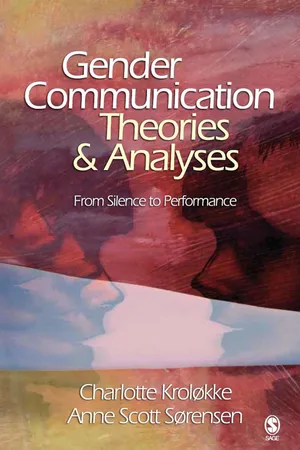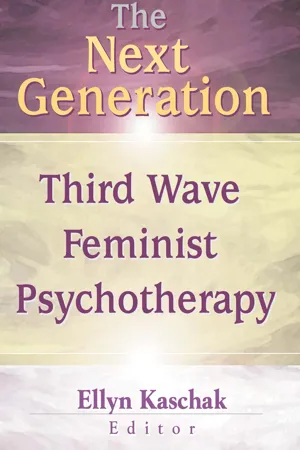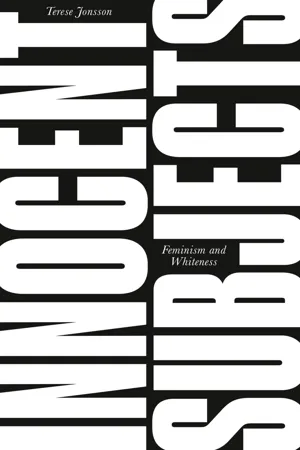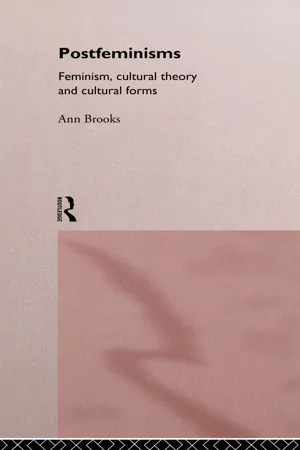History
Third Wave Feminism
Third Wave Feminism emerged in the 1990s as a response to the perceived limitations of second-wave feminism. It sought to address issues of intersectionality, diversity, and inclusivity, emphasizing the experiences of women of color, LGBTQ+ individuals, and those from marginalized communities. This wave also embraced the use of technology and social media as tools for activism and empowerment.
Written by Perlego with AI-assistance
Related key terms
Related key terms
1 of 4
Related key terms
1 of 3
11 Key excerpts on "Third Wave Feminism"
- No longer available |Learn more
Feminist Thought
A More Comprehensive Introduction
- Rosemarie Tong, Tina Fernandes Botts(Authors)
- 2018(Publication Date)
- Routledge(Publisher)
10Third-Wave and Queer Feminisms
Third-Wave Feminism
Most scholars think that third-wave feminism officially started with the coining of the term in 1992 by Rebecca Walker1 and the activism of feminist/ womanist women of color. The 1980s and 1990s saw “white feminism” fade as women of color voiced the matters of most concern to them. According to R. Claire Snyder, third-wave feminists made two significant “tactical moves that responded to a series of theoretical problems within the second wave [of feminism].”2 First, in response to the collapse of the essentialist concept of woman, they brought to the fore “personal narratives that illustrate[d] an intersectional and multiperspectival version of feminism;3 second, “in response to the ascendance of postmodernism, third-wave feminists embraced multivocality over synthesis and action over theoretical justification.”4Third-wave feminism resists simple description. Its writers have produced numerous varied and multifaceted works in a short period, a phenomenon that makes the approach difficult to thematize. Nonetheless, if third-wave feminists share any single characteristic, it is their willingness to accommodate diversity and change. They are fairly characterized as feminist sponges, able and ready to absorb some aspects of all the modes of feminist thought that preceded the third wave’s emergence. They are particularly eager to understand how various forms or axes of oppression cocreate and comaintain each other. The term they use for this phenomenon is “intersectionality” (see Chapter 4 ).Broadly speaking, for third-wave feminists, difference is the way things are. Moreover, they expect and even welcome contradiction, including self-contradiction, as well as conflict. In fact, two leading third-wave feminists, Leslie Heywood and Jennifer Drake, commented, “Even as different strains of feminism and activism sometimes directly contradict each other, they are all part of our third-wave lives, our thinking, and our praxes: we are products of all the contradictory definitions of and differences within feminism, beasts of such a hybrid kind that perhaps we need a different name altogether.”5 - eBook - ePub
Feminisms in Leisure Studies
Advancing a Fourth Wave
- Diana Parry(Author)
- 2018(Publication Date)
- Routledge(Publisher)
While the second wave worked to highlight many inequities, the knowledge generated during this period was not representative of all women’s lived experiences. As noted by hooks (2000), the second wave of feminism was a largely liberalist movement focused on advocating issues mostly relevant to the lives of White, middle-class, heterosexual women. In this context, second wave scholarship often overlooked difference and excluded women of diverse ages, ethnic identities, sexualities, socio-economic status, as well as men (Dean, 2009). Based on its exclusions, the second wave is viewed by some as judgemental, inflexible, and divisive (Braithwaite, 2002; Snyder, 2008; Snyder-Hall, 2010).Unlike the second wave, there is considerable debate as to when the third wave of feminism began. Contemporary feminists recognize an important moment when Rebecca Walker wrote an article for Ms magazine in 1992, which criticized the appointment of Clarence Thomas to the Supreme Court of the United States1 and introduced the concept of Third Wave Feminism:To be a feminist is to integrate an ideology of equality and female empowerment into the very fiber of life. It is to search for personal clarity in the midst of systemic destruction, to join in sisterhood with women when often we are divided, to understand power structures with the intention of challenging them.(pp. 39–41)Walker ended this article with the bold proclamation: “I am the Third Wave.” Regardless of its arrival date, the third wave of feminism is firmly located in the socio-political culture of the late 1980s and early 1990s, and is overwhelmingly grassroots-oriented, individualistic, radical, diverse, and informal (Shugart, 2001). With a wariness for unifying conceptualizations of womanhood and subjectivity, Third Wave Feminism embraced a multiplicity of feminist ideologies and praxes (Kinser, 2004). Despite the fractal nature of this wave, Parry and Fullagar (2013) call attention to five dominant tendencies that hold it together as a collective movement: (i) plurality and inclusivity, (ii) personal narrative, (iii) self-determination, (iv) gender equality and sexual freedom, and (v) popular culture (p. 572). While not everyone agrees that this wave of feminism is generational, many scholars are currently challenged with creating a space for their work between previous waves and emergent postfeminist rhetoric.“Postfeminism” is a term that suggests the work of feminism is complete and no longer relevant or necessary (Braithwaite, 2002). This right-wing populist and gendered discourse works to promote hostile reactions to earlier forms of feminist action and research and negatively construct feminism and feminists as undesirable, restricting, controlling, and dogmatic (Braithwaite, 2002; Kinser, 2004). Hence, a key challenge of Third Wave Feminism is clearly communicating its continued relevance and difference from postfeminism – especially given the emergence of postmodern and poststructural critique (see Gillis & Munford, 2004; MacCormack, 2009). The inconsistent use of postfeminism and confusion about its meaning functions to perpetuate misunderstandings about feminist perspectives on gender difference, agency/subjectivity, structure/discourse, activism, and the roles of theory as explanatory or analytic. - eBook - ePub
Feminism
A Beginner's Guide
- Sally J. Scholz(Author)
- 2012(Publication Date)
- Oneworld Publications(Publisher)
5Language, thought, and cultural production: the third wave
Third Wave Feminism is greatly indebted to first and second wave feminism; it assumes many of the same struggles and also adds a new layer for feminist criticism. Some third wave feminists, drawing on postmodernism and deconstruction, reject ‘theory’ as too totalizing or universalizing. Theory might be replaced with narratives or new ways of writing but the idea for these feminists is to unsettle some of the metaphysical categories – such as ‘woman’ – upon which theory relies. Other third wave feminists embrace new forms of theory and new ways of doing feminism. Similar to the other waves discussed in the previous two chapters, not everyone who identifies as a third wave feminist agrees on the topics, issues, and methodologies that best advance the feminist cause and not every feminist I will discuss using this thematic approach to the waves would necessarily embrace any particular ‘wave’ designation. Nevertheless, there are common threads. In this chapter, I use the thematic organization to explore third wave feminist accounts of the structures of consciousness and language but I also present some of the new strategies for social change. Like first wave and second wave feminism, third wave involves some creative uses of culture in order to advance the feminist cause.MethodologyThe methods of Third Wave Feminism are often quite different from second wave and at times there has been real animosity between second and third wave feminists. There is no consistent ‘third wave methodology’ but there are some definite trends. Four trends are: (1) multiplicity and the rejection of norms, (2) critique of the structures of consciousness, (3) use of popular culture, and (4) political coalition building in spite of ideological differences.Third wave feminists embrace radical multiplicity even within an individual. Influenced by the postmodern and deconstructionist philosophers of the late twentieth century, postmodern feminists, for instance, reject an essentialist notion of self identity. The self is always changing or is never the same from moment to moment. Some draw upon psychoanalysis to substantiate this position and criticize phallocentric or phallogocentric culture. - eBook - ePub
Empowerment and Autonomy of Women
Ushirika wa Neema Deaconess Centre in the Evangelical Lutheran Church in Tanzania, Northern Diocese
- Lyimo(Author)
- 2016(Publication Date)
- Resource Publications(Publisher)
5Third-Wave Feminism and Empowerment Theories
IntroductionT his chapter discusses the Third-Wave feminism theories which began in the 1990 s to the present. These theories are crucial because they involve the economic, political, social, and personal empowerment of women. However, this chapter is divided into several sub-sections which are: The Third-Wave of Feminism Theories, Empowerment Approach, Origin of the Empowerment, Empowerment Views and Power as a Process of Human Relations, Components of Women Empowerment, Women Empowerment, Economic Empowerment and Educational Empowerment.Third-Wave Feminist TheoriesThird-Wave feminism is a feminist movement that began in the 1990 s. It involves economic, political, social, and personal empowerment of women. Also, it focuses more on the individual empowerment of women than on activism. It promotes women to build meaningful identities in the complex contemporary world. Third-Wave feminism encourages personal empowerment and action as a starting point for promoting changes in the society. It involves diversity of women compared to the second-wave feminism which focused on middle-class white women. It usually includes anti-racism, postcolonial theories, postmodernism theories, broader construction of gender, and subordination of women and how to empower them in different contexts.128The rise of feminist theories has been a special approach which empowers women to challenge gender inequalities in the society with the focus of promoting positive changes. Feminist researchers have conducted several studies which identify gender inequalities in the society and church. For instance, young insists that women should identify their oppressions which are around them and find ways to get rid of them. She further argues:Feminist theology draws on the broader project of feminist theory. Although feminists differ in the ways they analyze women’s oppression, they do agree on certain fundamental themes. Arising out of feminist consciousness and feminist political and social action, feminist theory recognizes the systematic oppression of women and encourages women to name their oppression and to ponder its sources. Various feminist theorists see the importance of providing a theoretical accounting of women’s situation so as to understand the communality of women’s oppression on the one hand while not denying variety of women’s experiences on the other. - eBook - ePub
SlutWalk
Feminism, Activism and Media
- K. Mendes(Author)
- 2015(Publication Date)
- Palgrave Macmillan(Publisher)
Although postfeminism is often used interchangeably with Third Wave Feminism (for a discussion, see Genz & Brabon 2009), and has been thought to have been used more widely used in the US than in say Europe or the UK (Hollows & Moseley 2007), Third Wave Feminism is increasingly being understood as the next ‘wave’ of feminist resistance (after the First and Second). Emerging in the 1990s, scholars understand that Third Wave Feminism is not the same as postfeminism, which assumes feminism’s work has been achieved, but instead is made up of feminist activists who operate in a postfeminist context, as described above (Baumgardner & Richards 2000). Like Second Wave feminists before them, Third Wave activists continue to pursue many of their predecessors’ struggles, but do so in different ways (Heywood & Drake 1997). As a result, Third Wave Feminism has also been used (often rather unhelpfully) to indicate a generational shift which has caused tension between feminists, and has been used as a means of de-legitimizing Second Wave feminist activities (Henry 2004; Mendes 2012). On the other hand, unlike the Second Wave, which attracted criticism, particularly from black feminists, the Third Wave has been informed by postmodern critiques of identity and the individual, and often incorporates intersectional analyses from black feminist and post-colonial theory and does not necessarily regard gender as the key, or only, area of oppression (Genz & Brabon 2009; Reed 1997). As a result, Third Wave feminist activism is extremely diverse (Maddison 2013a), and unlike the Second Wave, which had clearly identifiable goals, organizations and even leaders (Henry 2004), the Third Wave doesn’t have an easily identifiable presence but, is instead made up of ‘hubs that are unique to this generation’ (Baumgardner & Richards 2000, p. 79). While these ‘hubs’ are increasingly found online, they do of course take form in offline spaces, as we saw with SlutWalk.Another key characteristic of the Third Wave is its engagement with digital, do-it-yourself media (Keller 2013; Zobl & Drueke 2012). Although Third Wavers are interested in ‘politics,’ they pay particular attention to cultural activism, which scholars argue has long been ignored as activist practice (Harris 2008a; Keller 2013; Piepmeier 2009; Young 1997). This cultural activism includes textual and cultural production such as culture jamming, zine-making or blogging, where the aim is to raise feminist consciousness rather than forming large-scale social justice movements, or bringing about legislative or government change (Henry 2004; p. 43; Piepmeier 2009). As we will come to see through this book, the proliferation of SlutWalk Facebook groups, Twitter accounts, and other local events indicates the various ways Third Wave activists engage in discursive politics and activism by disrupting hegemonic discourses on rape and rape culture. - eBook - ePub
Third Wave Feminism and Transgender
Strength through Diversity
- Edward Davies(Author)
- 2018(Publication Date)
- Routledge(Publisher)
The third wave considers these effects of modern life while drawing from developments made in other feminist waves to form what is arguably an identifiably new feminism. However, it can be contended that Third Wave Feminism shouldn’t necessarily have to present itself as different to the first two waves just for the sake of innovation or novelty. This contention mirrors the way that some contemporary trans narrators have endeavoured to understand the effects of trans subjectivity rather than pursue a quest for its aetiology and definition. 1 Nevertheless, as Rebecca Walker speculated of the new generation of feminist writers, ‘ They change the face of feminism as each new generation will, bringing a different set of experiences to draw from, an entirely different set of reference points, and a whole new set of questions ’ (1995:xxxiv). Whether these new writers are ‘third wave’ is an area for speculation, partly because few feminists seem to self-describe as ‘third wave feminist’. This may be because feminists prefer to investigate rather than administer labels and are still investigating the nature and validity of the label, ‘Third Wave Feminism’. Below are four suggested areas that appear to suggest the nature of third wave philosophy, a philosophy-in-process that relates to, and holds potential to empower, gender variant subjectivities and transgender and feminist theories in their interactions with the law. 3.1 ‘Personally political postmodern identity’ During the 1960s and 70s, or what might be called the chronological second wave, feminism was very much influenced by social construction theory. This opened up the nature/nurture debate with regard to the development and essence of gender and later became of importance to trans people searching for explanations of their trans subjectivity - eBook - ePub
Gender Communication Theories and Analyses
From Silence to Performance
- Charlotte Kroløkke, Anne Scott Sorensen(Authors)
- 2005(Publication Date)
- SAGE Publications, Inc(Publisher)
1 Three Waves of Feminism From Suffragettes to GrrlsW e now ask our readers to join us in an exploration of the history of feminism or, rather, feminisms: How have they evolved in time and space? How have they framed feminist communication scholarship in terms of what we see as a significant interplay between theory and politics? And how have they raised questions of gender, power, and communication?We shall focus our journey on the modern feminist waves from the 19th to the 21st century and underscore continuities as well as disruptions. Our starting point is what most feminist scholars consider the “first wave.” First-wave feminism arose in the context of industrial society and liberal politics but is connected to both the liberal women’s rights movement and early socialist feminism in the late 19th and early 20th century in the United States and Europe. Concerned with access and equal opportunities for women, the first wave continued to influence feminism in both Western and Eastern societies throughout the 20th century. We then move on to the second wave of feminism, which emerged in the 1960s to 1970s in postwar Western welfare societies, when other “oppressed” groups such as Blacks and homosexuals were being defined and the New Left was on the rise. Second-wave feminism is closely linked to the radical voices of women’s empowerment and differential rights and, during the 1980s to 1990s, also to a crucial differentiation of second-wave feminism itself, initiated by women of color and third-world women. We end our discussion with the third feminist wave, from the mid-1990s onward, springing from the emergence of a new postcolonial and postsocialist world order, in the context of information society and neoliberal, global politics. Third-wave feminism manifests itself in “grrl” rhetoric, which seeks to overcome the theoretical question of equity or difference and the political question of evolution or revolution, while it challenges the notion of “universal womanhood” and embraces ambiguity, diversity, and multiplicity in transversal theory and politics. - eBook - ePub
The Next Generation
Third Wave Feminist Psychotherapy
- Ellyn Kaschak(Author)
- 2018(Publication Date)
- Routledge(Publisher)
Young women today are growing up during a cultural backlash, and gender inequality is viewed as something of the past. In fact, the popular press has recently pronounced the death of feminism (see Bellafante, 1998). At the same time, with the establishment of women’s studies programs on college campuses across the nation, feminist theory is even more accessible and perhaps more “sophisticated” than ever before. We believe the conflicting messages arising from this particular socio-historical moment are embodied in the types of feminist expression emerging from the new wave of feminists. Young feminists are speaking up about the contradictions they experience as young women and as feminists in a manner informed by postmodern, multicultural, and queer theories. 2 This “third wave” is creating its own feminist agenda, one which both overlaps with and departs from traditional feminism. Third wave feminists aim to disrupt, confuse, and celebrate current categories of gender, sexuality, and race. These categories are typically both defined by, and resisted and/or celebrated through, body and physical appearance; therefore, in this essay we explore the personal and political aspects of Third Wave Feminism primarily by examining young women’s relationships with their bodies. Amelia Richards remarks that “body image may be the pivotal third wave issue–the common struggle that mobilizes the current feminist generation” (1998, p. 196). Whether body image is the issue for young feminists, or just one important part of the third wave feminist “agenda,” it is certainly an issue that young women are excited to speak about. Having had their consciousness raised in the academy, rather than through consciousness-raising groups that build on one’s lived experience (as their feminist foremothers did), third wavers are crying out for space in which to examine their unique concerns as young feminists, the contradictions and ambiguities they struggle with in claiming a feminist identity - eBook - ePub
Innocent Subjects
Feminism and Whiteness
- Terese Jonsson(Author)
- 2020(Publication Date)
- Pluto Press(Publisher)
the popular narrative that feminist activity across the twentieth and twenty-first centuries can be categorised into distinct ‘waves’. I will return to discuss how feminist waves are conceptualised in relation to race at various points in both this and the following chapter. For now, suffice it to say that within dominant narratives of feminism, the first wave is associated with Western (particularly British and US) suffrage movements in the early 1900s, the second wave is associated with Western women’s liberation movements in the 1960s and 1970s, and the third wave is associated with younger generations of women who have grown up in Western societies after the significant cultural and legislative changes generated by the so-called second wave. Some, as will be discussed in Chapter 4, also conceptualise a distinct fourth wave of feminism, associated with the rise in social media and online activism in the last decade. Wave narratives have been critiqued and problematised from a number of perspectives, not least for their tendency to centre around white and Western – particularly Anglo-American – women’s activism. As Kimberly Springer writes about the US context, successive generations of Black feminist histories have been ‘drowned out by the wave’. 6 Woodward and Woodward challenge simplistic narratives about second and Third Wave Feminisms. They question what they see as a divisive antagonism set up between these two waves, and aim to move feminist theory forward while retaining key concepts from the past. They do so by constructing an inter-generational dialogue between themselves as mother (Kath) and daughter (Sophie), about Western feminisms past and present. They argue for the need to salvage what they consider to be key concepts from second wave feminism, which they see as at risk of being lost - eBook - ePub
Different Wavelengths
Studies of the Contemporary Women's Movement
- Jo Reger(Author)
- 2014(Publication Date)
- Routledge(Publisher)
Online discussion groups and other online feminist organizations are now able to quickly activate through immediate asynchronous networks. Moreover, online feminist discussion groups explore the idea of creating a home, a place where participants can replenish and sustain themselves for their everyday and ongoing activist goals. Activism in many of these third wave communities is what Jennifer Baumgardner and Amy Richards refer to as an “everyday activism” that has no immediate or directly visible effects or consequences. 1 In this sort of activism, leaders are not as visible, and groups are formed in response to immediate and temporary political actions. Although it may seem vague and ambiguous in its effects, third wave activism has the potential for a slow accretion of results and the ability to make change on a personal everyday level. Activism in third wave communities rarely results in definitive, immediate, or decisive victories; rather, it is molded by small, everyday, niche events or protests, and is driven by temporary leaders who take up for a particular cause at a particular time. While this is also true for second wave feminism, Third Wave Feminism provides, through the medium of technology, a potentially strong voice to every participant, and a mobilized and ever present sense of home and community - eBook - ePub
Postfeminisms
Feminism, Cultural Theory and Cultural Forms
- Ann Brooks(Author)
- 2002(Publication Date)
- Routledge(Publisher)
1 Consensus and Conflict in Second Wave Feminism Issues of diversity and ‘difference’ in feminist theorising DOI: 10.4324/9780203428894-1 Introduction This first chapter investigates feminism’s location at the intersection of modernity and postmodernity, and examines some of the debates which have been leading feminism towards a possible paradigm shift. As it confronts critiques from within and outside its own discourses, contemporary feminism is reassessing its epistemological foundations within modernism. This chapter considers some of these critiques and assesses the implications for feminist theoretical and political debates in the 1990s. Feminism, Modernity and Postmodernity Feminism has always engaged with the ‘master’ discourses with which it has found itself allied, whether they are the discourses of modernity or postmodernity. It cannot be denied that the theoretical frameworks and principles of operation which have characterised feminism have been the result of feminism’s intersection with these discourses, either the ‘metanarratives’ of modernity, e.g. Marxism, or the postmodernist and poststructuralist discourses of postmodernity. The relationship between feminism and modernity is not a straightforward one. Marshall (1994 :148) notes the relationship of women to modernity and to social theory as a modern project is one riven with contradictions and ambiguities. She claims that feminism ‘constitutes both a critique of and a defence of modernity, so has a great stake in the modernity-postmodernity debates which are at heart about the possibility of a “subject” for social theory’. The failure of theories of modernity for feminism has been their inability to come to grips with ‘difference’ adequately. Thus, on the one hand, as an emancipatory politics and a body of critical and political theory, feminism continues to use ‘egalitarian rhetoric as the basis of most of its political demands’
Index pages curate the most relevant extracts from our library of academic textbooks. They’ve been created using an in-house natural language model (NLM), each adding context and meaning to key research topics.
Explore more topic indexes
Explore more topic indexes
1 of 6
Explore more topic indexes
1 of 4
